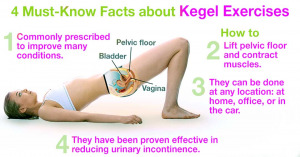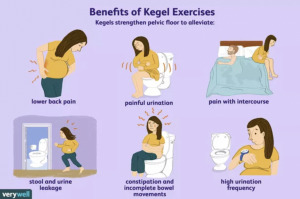We get it – it’s hard enough to fit a dedicated fitness routine into your daily life. But even if you ghost your trainer or skip your cardio class, there’s one workout you should regularly make time for, no matter what your maternal status: we’re talking about pelvic floor exercises.
Ladies, if you thought that kegels were just for women with kids, you’re not alone – I, too, brushed them off as an activity that didn’t apply to me, as someone who has never been pregnant. But as it turns out, pelvic floor exercises serve important purposes in addition to helping you bounce back postpartum. Here, we turned to pelvic health expert and certified fitness trainer Kim Vopni – also known as The Vagina Coach – for the lowdown on these simple strengthening moves that can bulletproof your core, at any age or stage.
What Is The Pelvic Floor?
The pelvic floor consists of muscles that sit at the base of your pelvis and stretch from your tailbone to your pubic bone. You can think of them as forming a sort of hammock to support your pelvic organs above, which include the vagina, uterus, cervix, urethra, and rectum.
The layers of these muscles play a role in everything from sexual response and continence to pelvic and spinal stability, Vopni notes. “They are the foundation of our core,” she says.
Just as you’d work out any other muscle, “the pelvic floor muscles benefit from exercises to both strengthen the muscles and also lengthen the muscles,” Vopni explains. A weak pelvic floor loses the ability to support the pelvic organs, which can lead to pelvic floor disorders like organ prolapse and incontinence. Pelvic floor exercises can help you maintain a strong and healthy pelvic floor and prevent these issues from happening, or help you recover from symptoms like urine leakage or bowel problems if you’re already experiencing them.
The most common pelvic floor exercise – which you’ve probably heard of, even if you’re not sure how to pronounce it – is the kegel (and it’s pronounced KAYgl, by the way).
What Are Kegel Exercises?
“Kegels are often the pelvic floor exercise most pursued if someone is experiencing symptoms of incontinence or organ prolapse,” Vopni says. “They are a voluntary contract, lift, and release of the pelvic floor muscles, though most understand a kegel as just a squeeze.”
If you’re having trouble controlling your urine flow or bowels, committing to kegels three times per day can lead to a reduction in symptoms within four to six weeks. Here’s how to perform a kegel the right way, according to MedlinePlus:
-
Start with an empty bladder. Sit or lie down in a comfortable position.
-
Tighten (squeeze) your pelvic floor muscles. Hold and count for 3 to 5 seconds.
-
Relax (release) the pelvic floor muscles and count for 3 to 5 seconds.
-
Breathe deeply (exhale and inhale) as you are performing these movements.
-
Repeat 10 times, 3 times per day (morning, afternoon, and night).
Not sure if you’re targeting the right muscle group? Vopni recommends trying this visualization technique as you perform the exercise:
-
As you exhale, imagine that you are picking up a blueberry with your vagina and anus. (This is the squeeze and lift.)
-
As you inhale, imagine that you are putting the blueberry back down. (This is the release.)
“There is a balance between effort and ease that is an essential component,” Vopni points out. “Some may need to focus more on the squeeze, some on the lift, and others on the release.”
How Can You Get The Most Out Of Kegel Exercises?
While kegels are a preferred way to get your pelvic floor from flimsy to fit, they work best when incorporated into a regimen that includes movement, Vopni says.
“The limiting factor in kegels is that they are a static exercise, meaning they are done while sitting or lying down, or even standing in place,” she explains. “The pelvic floor benefits from dynamic exercise – and by adding kegels to movement, we can achieve this while also training the pelvic floor to respond to forces that can often contribute to incontinence and prolapse symptoms.”
An easy movement you can start with is the bridge, Vopni recommends. “The bridge involves lying on your back with your knees bent, and then lifting your bum off the floor and pressing your hips upwards,” she says. “When you add the breath and kegels to this (often referred to as the core breath), you would exhale and imagine picking up your blueberries and press your hips up to the ceiling. On the inhale, you let the blueberries go and lower your bum back down.”
Who Can Benefit From Pelvic Floor Exercises?
“Anyone with a pelvic floor can benefit from pelvic floor exercises,” Vopni says. “However, most people don’t do them unless there is a problem to overcome.”
The most common pelvic floor problems include incontinence, organ prolapse, and pelvic pain, Vopni explains. “Those with pelvic pain often have overactive pelvic floor muscles and may benefit from spending more time on the release aspect of a kegel,” she points out. “Interestingly, those with prolapse and incontinence often have overactive muscles as well. This is often difficult to comprehend, but muscles that are too tight or not releasing are not strong. By releasing tension and taking the pelvic muscles through their full range of motion, strength can be improved and symptoms can be diminished.”
But don’t think that just because you’re not battling symptoms, you won’t benefit from pelvic floor exercises. Practicing these movements regularly can build strong muscles that can react at the right time and with the right amount of force for the task at hand. “We want pelvic floor muscles that can relax to allow for elimination and muscles that can contract to close the openings when we don’t want things to come out,” Vopni explains. “Essentially, we want a balance between effort and ease.”
And when your pelvic floor muscles are balanced and working optimally, benefits can include better bowel and bladder control, reduced constipation, more pleasurable sex, stronger lifts during resistance training, improved blood flow, and reduced back pain. “Over 95% of women with low back pain have some sort of pelvic floor dysfunction,” Vopni notes. “A surprising benefit of working on our pelvic health is no more back pain and a stronger core.”
When Should You See A Pelvic Floor Physical Therapist?
Sold on steamier sex and stronger lifts? You can probably start with a basic pelvic floor routine at home (see above!). But if you’re experiencing troublesome symptoms like incontinence, prolapse, or pelvic pain, you should consider seeing a pelvic floor physical therapist. “They can evaluate your pelvic floor and help ensure you are doing kegels correctly, as well as what part you need to focus on,” Vopni explains.
Pelvic floor physical therapy may become especially important during certain life stages like first insertive sexual experience, pregnancy or childbirth, and menopause, Vopni says. During these stages, pelvic floor symptoms may appear for the first time or be exacerbated.
Remember, there’s no shame in asking for help – only power in building a strong, healthy pelvic floor. “Most women walk away from their first appointment asking themselves how this is the first time they have ever learned about this,” Vopni points out. “It is empowering and can transform lives, especially for those who have been suffering from pelvic floor dysfunction.”
To find a pelvic floor physical therapist near you, visit the pelvic health directory of the Academy of the American Physical Therapy Association (APTA) at aptapelvichealth.org/ptlocator/.
And don’t forget to breathe.

Are you working out your pelvic floor? Tell us in the comments!
Keep Scrolling To Read More Health And Wellness Articles:




